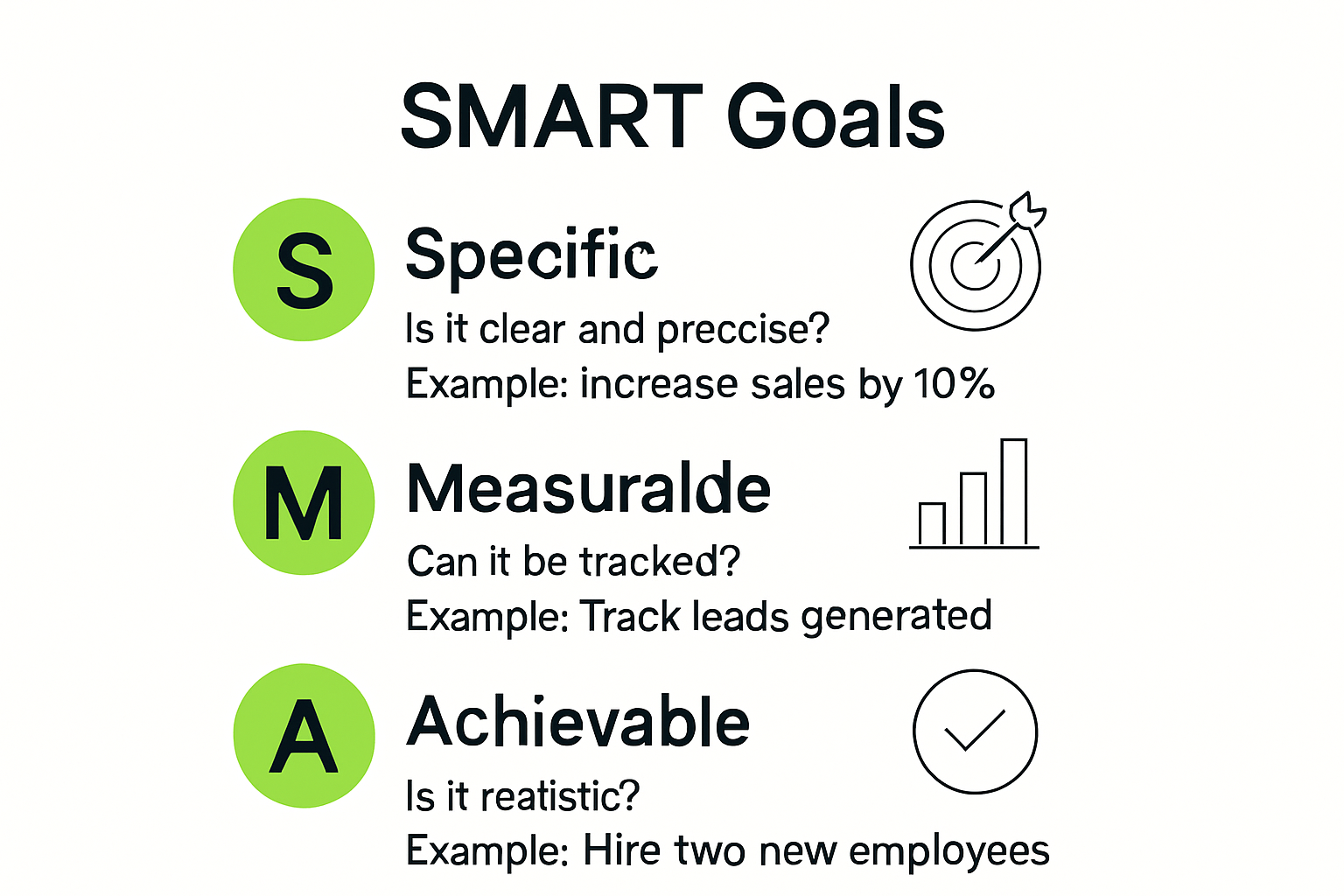
How to Set Business Goals in 2025: A Guide for New Entrepreneurs
Setting business goals can feel overwhelming for new entrepreneurs, but it has a direct link to real success. Research shows that targeted goal setting boosts performance in 90 percent of cases. Surprised? Most people assume that success hinges on hustle and luck, not on writing out dreams. The real secret is that well-crafted goals actually create the roadmap, accountability, and focus that separate real progress from wishful thinking.
Table of Contents
- Why Setting Business Goals Matters
- The Strategic Backbone Of Business Success
- Motivation And Accountability Through Goal Setting
- Measuring Progress And Adapting Strategically
- Steps To Define Achievable Business Goals
- Understanding The SMART Framework
- Conducting Strategic Analysis
- Breaking Down Complex Goals
- Goal-Setting Frameworks For First-Time Founders
- The Lean Startup Approach
- The GROW Model For Personal And Business Goal Setting
- Objectives And Key Results Framework
- Examples And Tips For Your First Goals
- Crafting Realistic Revenue And Growth Goals
- Customer Acquisition And Engagement Strategies
- Operational Efficiency And Personal Development
Quick Summary
Why Setting Business Goals Matters
Starting a business without clear goals is like embarking on a road trip without a map. You might eventually reach somewhere, but the journey will be inefficient, frustrating, and potentially wasteful. Goal setting transforms entrepreneurial chaos into strategic progression.
The Strategic Backbone of Business Success
Entrepreneurs who set specific and challenging goals are significantly more likely to achieve meaningful outcomes. Research indicates that targeted goal setting leads to higher performance in 90% of cases. This isn’t just motivational talk - it’s a scientifically proven approach to business development.
When you establish clear objectives, you create a strategic framework that guides every decision. Goals act as a compass, helping you navigate complex business challenges and maintain focus amid inevitable distractions. They provide a structured approach to turning abstract dreams into concrete milestones.

Motivation and Accountability Through Goal Setting
Beyond strategic planning, goals are powerful psychological tools. Studies show that establishing clear objectives enhances motivation and engagement by providing entrepreneurs with a sense of purpose. When you can visualize your destination, the journey becomes more meaningful.
Moreover, well-defined goals create natural accountability. They transform vague aspirations into measurable targets. Instead of saying “I want to grow my business,” you’re now saying “I aim to increase monthly revenue by 25% in the next quarter.” This specificity makes tracking progress not just possible, but straightforward.
Measuring Progress and Adapting Strategically
Business experts emphasize that establishing clear business objectives allows entrepreneurs to measure progress effectively. This measurement isn’t about rigid adherence but about creating a dynamic feedback loop. Goals become living documents that you can adjust as your business evolves.
Think of goals as your business’s GPS. They don’t just show you the route - they recalculate when you encounter unexpected obstacles. This adaptability is crucial in the unpredictable world of entrepreneurship. By setting clear, measurable goals, you’re not just planning - you’re building a resilient, responsive business strategy.
Remember: goals are not handcuffs. They’re powerful tools that transform entrepreneurial energy into focused, strategic action. Your future success depends not just on having goals, but on how intentionally you set and pursue them.
Steps to Define Achievable Business Goals
Defining achievable business goals isn’t about wild imagination - it’s about strategic planning and honest self-assessment. Successful entrepreneurs transform big dreams into executable roadmaps through systematic goal-setting approaches that balance ambition with practicality.

Understanding the SMART Framework
Goal-setting experts recommend utilizing the SMART criteria as a foundational strategy for defining business objectives. SMART stands for Specific, Measurable, Achievable, Relevant, and Time-bound - a framework that transforms vague aspirations into concrete action plans.
A specific goal answers the who, what, where, and why. Instead of saying “I want to grow my business,” a SMART goal would be “I will increase online product sales by 30% within the next six months by implementing targeted social media marketing campaigns.” This precision provides clarity and creates a clear target.
Measurability ensures you can track progress objectively. Achievability means the goal challenges you without being impossible. Relevance connects the goal to your broader business strategy, and time-bound elements create urgency and focus.
Conducting Strategic Analysis
Business strategists emphasize that performing a comprehensive SWOT analysis is crucial before finalizing goals. This process involves critically examining your Strengths, Weaknesses, Opportunities, and Threats.
Strengths might include unique skills, existing customer base, or proprietary technologies. Weaknesses could be limited resources, skill gaps, or operational inefficiencies. Opportunities might involve emerging market trends or technological innovations, while threats could include competitive pressures or economic uncertainties.
By mapping these dimensions, you create a nuanced understanding of your business ecosystem. This analysis helps you set goals that are ambitious yet grounded in realistic self-assessment.
Breaking Down Complex Goals
Goal achievement research indicates that breaking larger objectives into smaller, manageable steps dramatically increases the likelihood of success. This approach prevents overwhelm and creates a sense of progressive momentum.
For instance, if your annual revenue goal is $500,000, break this into quarterly targets of $125,000. Further subdivide these into monthly milestones, then weekly actions. Each smaller goal becomes a stepping stone, making the larger objective feel more attainable.
This granular approach also provides frequent opportunities for assessment and recalibration. You’re not waiting until year-end to evaluate progress - you’re constantly monitoring and adjusting your strategy.
Remember, goal-setting is an iterative process. Your first draft won’t be perfect, and that’s okay. The key is to start, remain flexible, and commit to consistent effort. Your goals are living documents that evolve as you grow and learn.
Goal-Setting Frameworks for First-Time Founders
For first-time founders, navigating the entrepreneurial journey can feel like sailing uncharted waters. Goal-setting frameworks provide critical navigational tools that transform uncertainty into strategic direction, helping new entrepreneurs convert their vision into actionable plans.
The Lean Startup Approach
Entrepreneurship experts highlight the Lean Startup methodology as a powerful framework for new founders. This approach prioritizes rapid experimentation and validated learning over traditional, rigid business planning. Instead of spending months developing a perfect product, lean methodology encourages building a minimum viable product (MVP) and iterating based on real customer feedback.
The core principle is to test business hypotheses quickly and cost-effectively. You create a prototype, present it to potential customers, gather insights, and continuously refine your offering. This approach minimizes wasted resources and helps founders pivot or adapt their business model before significant investments are made.
The GROW Model for Personal and Business Goal Setting
Leadership development research introduces the GROW model as an intuitive goal-setting framework. GROW stands for Goal, Reality, Options, and Way Forward - a structured approach that breaks down complex objectives into manageable components.
In the Goal stage, you define your specific, clear objective. Reality involves honestly assessing your current situation, including available resources and potential obstacles. Options explore different strategies to achieve your goal, while the Way Forward determines specific actions and commitments.
For entrepreneurs, this model provides a systematic way to approach challenges. It encourages critical thinking and helps prevent overwhelming complex goals by breaking them into actionable steps.
Objectives and Key Results Framework
Tech industry research demonstrates the effectiveness of the Objectives and Key Results (OKRs) framework, particularly popular among startup ecosystems. OKRs create a transparent, measurable approach to goal setting that aligns individual efforts with broader organizational objectives.
An objective is a qualitative, inspirational goal - something ambitious and forward-looking. Key Results are quantitative, measurable outcomes that indicate progress toward that objective. For instance, an objective might be “Establish a strong market presence,” with key results like “Acquire 100 paying customers” or “Generate $50,000 in monthly recurring revenue.”
This framework offers multiple advantages: it creates clarity, enables tracking, promotes transparency, and ensures that every team member understands how their work contributes to larger business goals. For first-time founders, OKRs can transform abstract ambitions into concrete, trackable milestones.
Remember, no single framework fits every entrepreneur perfectly. The key is experimenting, adapting, and finding an approach that resonates with your unique business vision and working style. These frameworks are tools, not rigid prescriptions - use them flexibly and creatively to guide your entrepreneurial journey.
Here is a comparison table summarizing the three goal-setting frameworks discussed, to help you quickly understand their focus and key features:
Examples and Tips for Your First Goals
The first set of business goals can feel like threading a needle while riding a rollercoaster. New entrepreneurs often oscillate between extreme ambition and paralyzing uncertainty. Understanding how to craft meaningful, achievable goals becomes your compass in this chaotic journey.
Crafting Realistic Revenue and Growth Goals
Entrepreneurship experts recommend transforming vague aspirations into precise, measurable objectives. Instead of saying “I want to make more money,” a strategic goal might be “Increase monthly revenue by 15% within the next quarter by introducing two new service packages and expanding digital marketing efforts.”
Consider breaking down your revenue goals into granular, trackable milestones. If your annual target is $100,000, break this into quarterly goals of $25,000. Then further subdivide these into monthly targets of approximately $8,333. This approach makes large objectives feel less intimidating and more systematically achievable.
The table below demonstrates how to break down an annual revenue goal into actionable milestones for easier tracking and execution:
Customer Acquisition and Engagement Strategies
Business strategists emphasize the importance of setting clear customer-related goals. A compelling example might be: “Acquire 50 new customers in the next six months through targeted social media advertising and referral programs, with a customer retention rate of at least 70%.”
Focus on quality over quantity. Your goals should reflect not just acquiring customers, but creating meaningful engagement. Track metrics like average customer lifetime value, repeat purchase rates, and customer satisfaction scores. These indicators provide a more holistic view of your business growth beyond simple numerical targets.
Operational Efficiency and Personal Development
Entrepreneurial research suggests that effective goal setting extends beyond financial metrics. Consider goals that improve your operational capabilities and personal skills. An example might be: “Reduce operational expenses by 10% in the next four months by streamlining workflow processes and implementing cost-effective digital tools.”
Personal development goals are equally crucial. These could include objectives like “Complete two professional certification courses in my industry” or “Develop advanced proficiency in digital marketing analytics within six months.” Such goals ensure you’re continuously evolving alongside your business.
Here is a summary table of example goals for different business dimensions, illustrating how to set actionable objectives in key areas:
Frequently Asked Questions
What is the SMART framework for setting business goals?
The SMART framework is a goal-setting strategy that ensures your objectives are Specific, Measurable, Achievable, Relevant, and Time-bound. This approach helps transform vague aspirations into actionable plans.
How can new entrepreneurs set achievable business goals?
New entrepreneurs can set achievable business goals by understanding the SMART criteria, conducting a SWOT analysis, and breaking complex goals into smaller, manageable steps to create clear, actionable plans.
What are some effective frameworks for goal setting in startups?
Some effective goal-setting frameworks for startups include the Lean Startup approach, the GROW model, and Objectives and Key Results (OKRs). Each provides structured methods to align your goals with your business vision and strategy.
Why is it important to measure progress towards business goals?
Measuring progress towards business goals is important because it allows entrepreneurs to track their achievements, adapt strategies as needed, and ensure that their efforts align with overall business objectives. It creates a dynamic feedback loop for continuous improvement.
Ready to Turn Your Business Goals Into Action?
Setting the right business goals can feel daunting, especially when you are just starting out. The article above highlights the stress of turning big dreams into clear, achievable steps and the challenges of knowing where to start or how to prioritize. Pain points like feeling overwhelmed by goal-setting frameworks and struggling to break down ambitious targets can hold new founders back, delaying progress and creating unnecessary anxiety.
What if you could receive personalized, step-by-step guidance tailored to your unique business idea, and access immediate feedback based on proven strategies like SMART goals and OKRs? With siift, you can use AI to analyze your ideas, set actionable priorities, and track your growth without bias or gatekeeping. Start moving from ideas to results today. Let siift help set and achieve your 2025 business goals below.

see where you really stand





.svg)
.svg.png)



.svg)

